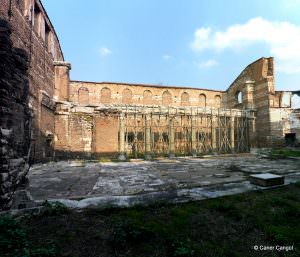İmrahor İlyas Bey Camii
Studios Manastırı, İmrahor Camii, Hagios Ioannes Prodromos Bazilikası olarak da bilinir.
- Tür: Cami, Kilise ve Manastır
- Tema: Camiye Çevrilen Kiliseler
- Kültür: Bizans, Osmanlı
- Yüzyıl: 15. yy, 5. yy
- Bölge: Türkiye, Marmara Bölgesi, İstanbul, Fatih, Yedikule

The Monastery of Stoudios, more fully Monastery of Saint John the Forerunner "at Stoudios" (Greek: Μονή του Αγίου Ιωάννη του Προδρόμου εν τοις Στουδίου, translit. Monē tou Hagiou Iōannē tou Prodromou en tois Stoudiou), often shortened to Stoudios, Studion or Stoudion (Latin: Studium), was a Greek Orthodox monastery in Constantinople (modern-day Istanbul), the capital of the Byzantine Empire. The residents of the monastery were referred to as Stoudites (or Studites). Although the monastery has been derelict for half a millennium, the laws and customs of the Stoudion were taken as models by the monks of Mount Athos and of many other monasteries of the Orthodox world; even today they have influence.
The ruins of the monastery are situated not far from the Propontis (Marmara Sea) in the section of Istanbul called Psamathia, today's Koca Mustafa Paşa. It was founded in 462 by the consul Flavius Studius, a Roman patrician who had settled in Constantinople, and was consecrated to Saint John the Baptist. Its first monks came from the monastery of the Acoemetae.










You must be logged in to post a comment.
Memduh Ün’ün 1960 yapımı Ölüm Peşimizde filminde Narlıkapı’daki İmrahor Camii içinde çekimler de yapılmış.
https://twitter.com/caner/status/1225529667882496027?s=20